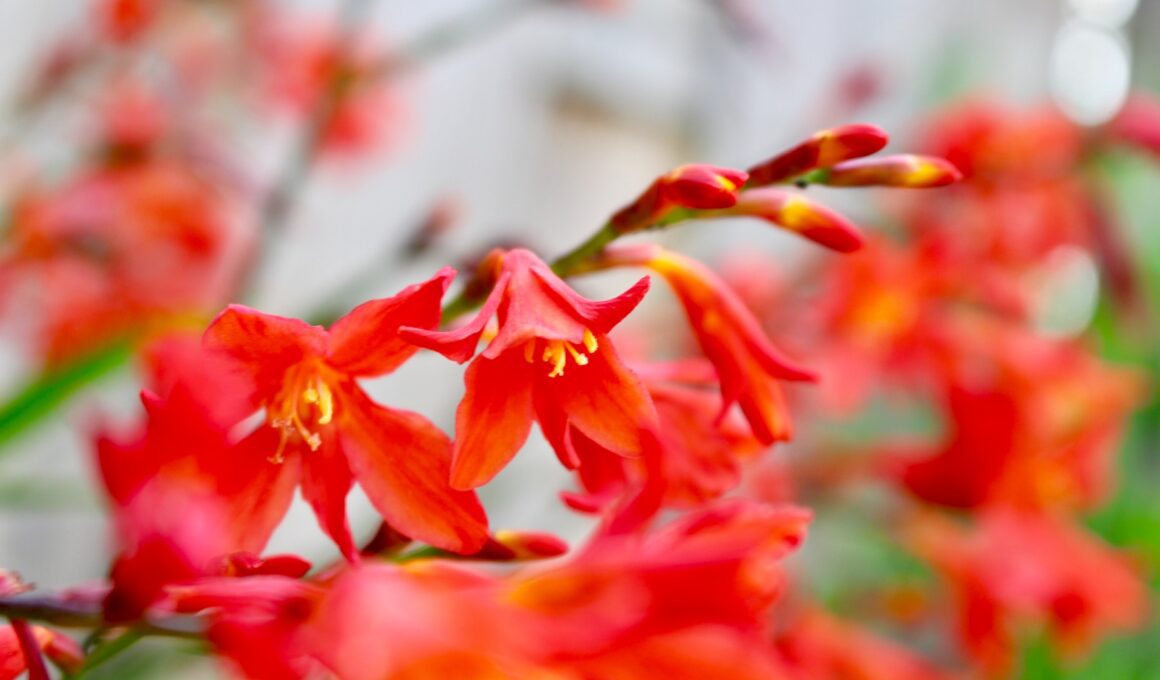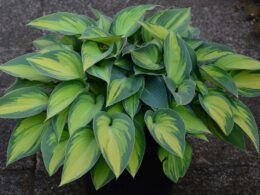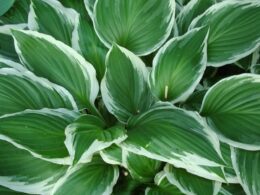Are you looking to propagate your crocosmia plants? Dividing them might just be the answer! Dividing crocosmia is an excellent way to ensure that your plant continues to thrive and grow, while also providing you with new plants to spread throughout your garden.
But when is the right time to divide crocosmia, and how should you go about it?
In this article, we’ll cover everything you need to know about dividing crocosmia, from understanding the need for dividing, to choosing the right time, to preparing for the process, and finally, caring for your newly divided plants.
By the end of this article, you’ll feel confident in your ability to propagate crocosmia successfully and safely. So let’s dive in!
Understanding the Need for Dividing Crocosmia
It’s important to comprehend why it’s necessary to divide and transplant mature crocosmia plants. Dividing crocosmia has numerous benefits, including promoting healthy growth, producing more blooms, and preventing overcrowding.
As a responsible gardener, you need to be aware of the signs of crocosmia overcrowding. Overcrowded crocosmia plants can quickly become unmanageable, leading to stunted growth and fewer blooms. If you notice that your plants are not producing as many flowers as they used to, it may be time to divide them.
Another sign of overcrowding is when the foliage becomes yellow or brown, indicating that the plants are competing for nutrients and space. By dividing your crocosmia plants, you can promote healthy growth and ensure that they continue to produce an abundance of beautiful blooms.
Plus, it’s an excellent opportunity to propagate new plants and share them with friends and family. So, keep an eye out for the signs of overcrowding, and don’t hesitate to divide your crocosmia plants when necessary.
Choosing the Right Time for Dividing Crocosmia
Now is the perfect time for you to split up those beautiful fiery flowers in your garden and give them a chance to thrive in new locations. Crocosmia should be divided every three to five years, or when they start to look overcrowded. Dividing them not only helps maintain their health, but it also keeps them from taking over your garden.
To divide crocosmia, you’ll want to have the best tools on hand. A garden fork and a sharp spade are essential to the process. First, use the garden fork to loosen the soil around the clump of crocosmia. Then, use the spade to dig up the clump and separate the individual corms. Be sure to cut any dead or diseased portions away before replanting.
Dividing crocosmia every few years will keep them looking their best and prevent them from becoming too invasive. Use the right tools and split them up during their dormant period, which is usually in the fall.
With a little care and attention, you’ll have a beautiful display of fiery flowers to enjoy year after year.
Should Crocosmia be Divided and Stored During Winter?
Winter care for crocosmia involves dividing and storing the bulbs to ensure their health and longevity. By dividing the plants during this season, gardeners can promote better growth and prevent overcrowding. Storing them in a cool, dry place, like a garage or basement, protects the bulbs from frost damage. Proper winter care is essential for the optimal performance of crocosmia in the following seasons.
Preparing for Dividing Crocosmia
Get ready to give your garden a fresh, vibrant look by splitting up those gorgeous, fiery flowers with the right tools and timing. Before you start dividing crocosmia, choose a location with well-draining soil that receives at least six hours of sunlight each day.
Crocosmia thrives in full sun to partial shade, so make sure the location you choose meets this requirement. Once you’ve chosen the location, prepare the soil by adding organic matter such as compost to improve drainage and fertility. Crocosmia prefers soil with a pH of 6.0 to 7.0, so consider adding lime or sulfur to adjust the pH if necessary.
You should also remove any weeds or debris from the area to ensure that your newly divided crocosmia plants have plenty of space to grow. Dividing crocosmia is an easy process that can be done with a sharp spade or garden fork. Dig around the clump of crocosmia and lift it out of the ground, being careful not to damage the roots.
Use your hands or a clean knife to separate the clump into smaller sections, each with at least one healthy shoot and root system. Once you’ve divided the crocosmia, replant the sections in the prepared soil, making sure to space them at least six inches apart. With proper care, your newly divided crocosmia plants will soon produce beautiful blooms that will brighten up your garden.
Step-by-Step Process of Dividing Crocosmia
When it’s time to divide your crocosmia, you’ll need to follow a simple three-step process.
First, dig up the entire plant carefully from the ground, making sure not to damage the corms.
Second, separate the corms into smaller sections, ensuring that each section has both roots and foliage.
Finally, replant the divided crocosmia in a new location, making sure to provide it with adequate water and sunlight.
Digging Up the Plant
Gently loosen the soil around the base of the plant with a digging fork. You can then carefully lift out the clump of crocosmia. Before digging up the plant, make sure you have all the necessary tools needed, such as a digging fork, sharp knife, and a clean container for the divided corms.
Once you have lifted the clump out of the ground, shake off the excess soil and separate the corms. When dividing crocosmia, it is important to dispose of excess corms properly. You can either give them away to friends or family or discard them in the compost bin.
Do not throw excess corms away in the trash as they are still living organisms that can potentially grow in the landfill and become invasive. By following these simple steps, you can successfully dig up your crocosmia and divide them for a healthier and more beautiful display in your garden.
Separating the Corms
Now it’s time for you to carefully separate the clusters of bulbs, gently teasing them apart with your fingers, revealing the potential for a stunning spread of vibrant blooms in your garden.
The best time to divide crocosmia is in the spring or fall, when the plant is not actively growing. Make sure to dig up the entire clump of bulbs and separate them carefully, so as not to damage the corms.
Once you have separated the corms, you can store them in a cool, dry place until you’re ready to replant them.
Crocosmia can be propagated by division, or by planting the corms directly into the soil. Whichever method you choose, make sure to give your crocosmia plenty of sunlight and well-draining soil, and water regularly to keep them healthy and thriving.
With a little bit of care and attention, your crocosmia will reward you with beautiful, vibrant blooms year after year.
Replanting the Divided Crocosmia
It’s time to get those vibrant clusters of bulbs back into the soil, where they can take root and blossom into a stunning display of color.
After separating the corms, it’s important to replant them properly to ensure their success.
Here are some replanting tips to help you achieve a beautiful garden:
First, make sure you are planting your crocosmia in the right soil. These plants prefer well-draining, slightly acidic soil that is rich in organic matter. You can amend your soil with compost or other organic materials to improve its quality and ensure your crocosmia have the nutrients they need to thrive.
When replanting, be sure to space the corms at least 6 inches apart and plant them just deep enough to cover the top of the corm.
Water thoroughly after planting and continue to keep the soil moist until the plants are established.
With these tips, your divided crocosmia will soon be flourishing in your garden.
Is Deadheading Crocosmia Necessary Before Dividing Them?
Deadheading crocosmia is not necessary before dividing them, but it can encourage new blooms. To deadhead, simply remove the faded flowers. When dividing, ensure each division has viable roots and shoots. Follow these crocosmia deadheading tips for a healthy and vibrant garden display.
Caring for Divided Crocosmia
Taking care of your newly separated crocosmia plants is crucial to ensure their healthy growth and vibrant blooms.
One important aspect of caring for divided crocosmia is watering frequency. While you want to make sure the soil is moist, you don’t want it to be too wet. Overwatering can lead to root rot, which can be detrimental to the plants. So, it’s important to strike a balance and water your crocosmia about once a week.
Another key element of caring for your divided crocosmia is ensuring that they have the right soil requirements. Crocosmia thrives in well-draining soil that is rich in organic matter. If your soil is heavy and clay-like, it’s a good idea to amend it with compost or other organic matter. This will help improve drainage and provide the necessary nutrients for your crocosmia to grow and thrive.
In addition to watering and soil requirements, it’s also important to keep an eye out for pests and diseases. Crocosmia can be susceptible to spider mites, thrips, and fungal diseases such as rust. Regularly inspecting your plants and taking action at the first sign of a problem can help prevent the spread of pests and diseases, and ensure the health and vitality of your crocosmia plants.
Frequently Asked Questions
What are some common mistakes to avoid when dividing crocosmia?
When it comes to dividing crocosmia, there are some common mistakes that you should avoid. One of the biggest mistakes is dividing them too early or too late in the season. It’s best to divide them in the spring or fall when the weather is mild and the plants are not actively growing.
Another mistake is not preparing the soil properly before planting the divided bulbs. Make sure to add compost or other organic matter to the soil to improve drainage and fertility.
Additionally, it’s important to not overcrowd the bulbs when planting them. Follow best practices by spacing them out properly to allow for proper growth and development.
By avoiding these common mistakes, you can ensure that your crocosmia will thrive and provide a beautiful addition to your garden.
Can crocosmia be divided during the blooming season?
If you want to divide your crocosmia during the blooming season, it’s not the best time for this task. The best planting time for crocosmia is during spring or fall.
Dividing techniques include digging the entire clump and separating it into smaller sections. Make sure each section has a healthy root system and at least one fan or shoot.
Keep the soil moist and provide adequate sunlight for the divided plants to establish themselves. Remember to avoid any common mistakes, such as planting too deep or too shallow.
With the right timing and techniques, you can safely divide your crocosmia and enjoy a beautiful and healthy garden.
How long does it take for divided crocosmia to establish in their new location?
If you’ve recently divided your crocosmia, you’re probably wondering how long it will take for them to establish in their new location. The establishment time for divided crocosmia varies depending on factors such as soil conditions, weather, and how well they were cared for during the transplant shock.
Generally, it can take several weeks to a few months for the plants to fully establish themselves and start growing again. During this time, it’s important to keep the soil moist but not waterlogged, and to avoid fertilizing until the plants have had a chance to settle in.
With patience and proper care, your divided crocosmia should thrive in their new location and reward you with beautiful blooms once again.
Is it necessary to use a specific type of soil when replanting divided crocosmia?
When replanting divided crocosmia, it’s important to use the right type of soil to ensure healthy growth. A well-draining soil that’s rich in organic matter is best for these plants. You can also mix in some sand or perlite to improve drainage.
When replanting, be sure to dig a hole that’s deep enough to accommodate the roots and gently pack the soil around the plant. It’s also important to water the plant immediately after replanting to help it establish itself in its new location.
By following these replanting techniques and using the appropriate soil type, you can help ensure the success of your divided crocosmia.
Can crocosmia be divided in regions with harsh winter climates?
If you live in a region with harsh winter climates and want to divide your crocosmia, there are a few important things to keep in mind for winter preparation.
First, make sure to divide the plants in the fall before the ground freezes. This will give the new divisions enough time to establish roots before the cold weather sets in.
When dividing, use sharp, sterilized tools to prevent the spread of disease. Additionally, be sure to plant the new divisions in a well-draining soil to prevent water from accumulating and freezing around the roots during the winter.
By following these dividing techniques and taking the necessary steps for winter preparation, you can successfully divide crocosmia in harsh winter climates.
Conclusion
Congratulations, you now know how to divide crocosmia! Dividing your crocosmia plants is important for their health and longevity. By dividing your crocosmia, you can ensure that they continue to produce beautiful blooms year after year.
Remember to choose the right time to divide your crocosmia, prepare the plant properly, and follow the step-by-step process. With a little bit of care and attention, your divided crocosmia will thrive and add beauty to your garden.
Keep in mind that while dividing crocosmia may seem intimidating at first, it’s a simple and rewarding process that any gardener can do. So, go ahead and give it a try!








